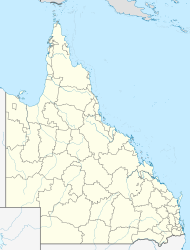world.wikisort.org - Australia
Bunya Mountains is a locality split between the Western Downs Region and the South Burnett Region, Queensland, Australia.[2] The town of Mount Mowbullan (26.8853°S 151.5972°E) is located on the boundary of Bunya Mountains and the enclosed locality of Mowbullan.[3] In the 2016 census Bunya Mountains had a population of 144 people.[1]
| Bunya Mountains Queensland | |||||||||||||||
|---|---|---|---|---|---|---|---|---|---|---|---|---|---|---|---|
 Bunya Mountains | |||||||||||||||
| Coordinates | 26.8780°S 151.55°E | ||||||||||||||
| Population | 144 (2016 census)[1] | ||||||||||||||
| • Density | 0.3881/km2 (1.005/sq mi) | ||||||||||||||
| Postcode(s) | 4405 | ||||||||||||||
| Area | 371.0 km2 (143.2 sq mi) | ||||||||||||||
| Time zone | AEST (UTC+10:00) | ||||||||||||||
| LGA(s) | |||||||||||||||
| State electorate(s) |
| ||||||||||||||
| Federal division(s) | Maranoa | ||||||||||||||
| |||||||||||||||
Geography
The locality is split between the two local government areas with the smaller north-eastern part of the locality in South Burnett Region and the larger south-western part in the Western Downs Region. The north-eastern part is almost entirely within the Bunya Mountains National Park with a small portion of the south-western part also in the National Park. In contrast most of the south-western part is freehold land used for agriculture but only a very small portion of the north-eastern part as freehold land, used for residential and agricultural purposes. The Bunya Mountain Road roughly follows the split between the two local government areas[4]
The Bunya Highway passes through the western corner of the locality.[4]
The locality of Mowbullan (in the Western Downs Region) is completely enclosed by the locality of Bunya Mountains and does not form part of the national park.[4] This enclosure within another locality is unusual in Queensland and contrary to the Queensland Government's normal policies.[5]
History
The locality name comes from the mountain range, Bunya Mountains, and is a Kabi language word bonyi or bunyi, indicating the Bunya pine tree (Araucaria bidwillii).[2]
Bunya Mountains Provisional School opened on 6 October 1919 and closed on 15 December 1922.[6]
From 1923 to 1928 a 670-metre tramway for 250 metre descent from mountain top to bottom at Wengenville, used with winches, winders and flying foxes.[7] The logs were transferred to a horse-drawn tram for movement to a log dump.[8] A “not to scale” model can be seen at the natural history museum at the Dandabah camping area.[9]
In the 2016 census Bunya Mountains had a population of 144 people.[1]
See also
- List of tramways in Queensland
References
- Australian Bureau of Statistics (27 June 2017). "Bunya Mountains (SSC)". 2016 Census QuickStats. Retrieved 20 October 2018.
- "Bunya Mountains – locality in Western Downs Region (entry 47673)". Queensland Place Names. Queensland Government. Retrieved 31 December 2017.
- "Mount Mowbullan – population centre in the South Burnett Region (entry 23105)". Queensland Place Names. Queensland Government. Retrieved 23 October 2019.
- "Queensland Globe". State of Queensland. Retrieved 2 January 2018.
- "Defining boundaries and extent". How places are named. Queensland Government. Archived from the original on 14 August 2019. Retrieved 19 January 2021.
- Queensland Family History Society (2010), Queensland schools past and present (Version 1.01 ed.), Queensland Family History Society, ISBN 978-1-921171-26-0
- "Bunya Mountains National Park - Nature, culture and history - Harvest of the bunya pine". parks.des.qld.gov.au. Queensland Government - Department of Environment and Science. 2019. Archived from the original on 29 November 2019. Retrieved 28 December 2019.
- Kerr and Philpott, JD and MM (1971). "Lars Andersen's Timber Tramways" (PDF). southburnett.biz. Queensland Heritage. Archived (PDF) from the original on 28 December 2019. Retrieved 29 December 2019.
- "Timber Tramway Lives Again". southburnett.com.au. South Burnett Online. 2 March 2015. Archived from the original on 28 December 2019. Retrieved 28 December 2019.
Другой контент может иметь иную лицензию. Перед использованием материалов сайта WikiSort.org внимательно изучите правила лицензирования конкретных элементов наполнения сайта.
WikiSort.org - проект по пересортировке и дополнению контента Википедии